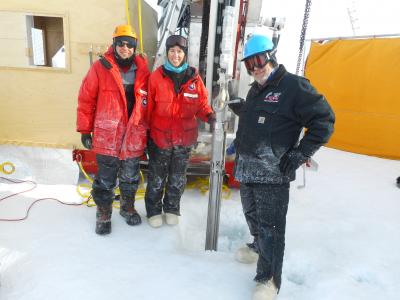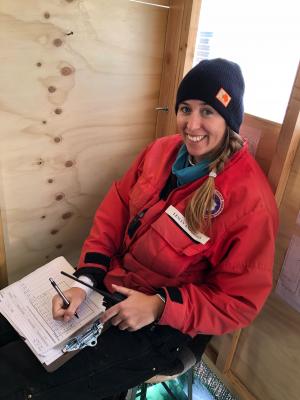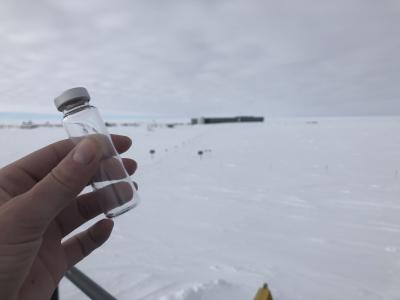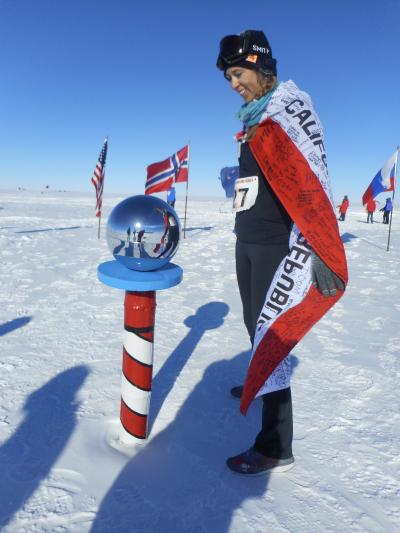Introduction
PolarTREC, the teacher-research program run through ARCUS (Arctic Research Consortium of the United States) and the National Science Foundation is a transformative, inspirational, and highly valuable experience for science teachers. Being provided with the opportunity to engage in authentic scientific practices allows teachers to enrich their own classroom activities and inspires the next generation of young scientists to care about polar regions and become invested in the science that is being conducted in these remote locations.
Science Overview
Getting to work on two different neutrino projects was a really inspiring experience. IceCube is an active large-scale neutrino observatory that is in its operational phase. In comparison, the Askaryan Radio Array (ARA) is in its build phase and provided the opportunity to participate in a project at a much earlier stage. The main deployment goal for ARA this season was to get the next stations in the array up and running. Our first step in doing that was to pull the drill off of the berms behind the station and thaw all of the components of the drill train so we could test the electronics. 
Meanwhile, the deployment team readied the sensors that would be lowered into the holes. They also prepared cables in the trenches that would lead from the new ARA stations back to the IceCube laboratory so that the data from the sensors could be stored and analyzed. Fiber optic cables were hand-laid in the trenches, and fiber connections needed to be made at each of the station vaults on the way back to the IceCube lab. The drill team was tasked with providing more than ten 200 meter deep, 8 inch diameter holes in the ice. Once the holes were finished, the deployment sled would move into place and the deployment team would lower the sensors into the hole. By the end of the season, two new stations were fully deployed, including the cables that carry data back to the IceCube laboratory.
Teacher-Research Importance
I have always placed value on the importance of teacher-research experiences, but PolarTREC has opened my eyes to new reasons why this experience is so impactful for teachers, students, and researchers alike. Teacher-researchers have the opportunity to be exposed to real world science and from that experience gain insight into the many ways that their classroom can become more like a working science laboratory. The skills that teacher-researchers develop through conducting real world science allow them to experience authentic inquiry practices which can then be included in their classroom practices. 
PolarTREC also taught me the importance of science communication. I realized that as fascinating as the science might be, if the science can’t be communicated to the general public, no one will be able to appreciate the importance of the work. As a teacher, and science communicator, I felt personally responsible for making sure I was effectively communicating the science to my students and the rest of the public by sharing my experience through journals, videos, and PolarConnect events. It has also changed my thinking in the classroom by emphasizing the importance of students being able to communicate their science. I have expanded an effort on literacy in the classroom which I think will contribute to a generation of more thoughtful and reflective scientists.
Connecting to My Classroom
Upon returning from the South Pole, I have been excited to share my research experience with 
Student and Community Impact
Many of my students had never considered the option of polar research before being in my class. Even before I left, we had group discussions about the harsh environment at the South Pole and many students were surprised to find this is the driest desert on the planet. 
I have also had many students share their excitement and enthusiasm for conducting their own polar research some day. I have a few students who have expressed interest in pursuing summer research experiences in the Arctic and Antarctic and I am actively helping them fill out applications before the summer deadlines.
Post-Expedition and Future Plans
In the near future, I am doing local outreach events in my community to share this science. I have presented at the National Partners in Science Conference just days after returning from the ice and I have several other informal presentations over the next few months. I am also looking forward to incorporating these new stories into my daily classroom teachings.
In the more distant future, I am actively seeking new opportunities to continue to participate in teacher-research professional development. I never want my teaching to become stagnant, and I think that getting involved with research experiences is the best way to keep fresh practices in my tool belt. I would also love to find another way to get back to Antarctica. This was such a transformative experience and unlike any other teacher professional development that I have experienced. The unique science and inspiring people that conduct their research in Antarctica make it such an intriguing place and I can’t wait to find a way to go back.

*This program is supported by the National Science Foundation under award 1345146. Any opinions, findings, and conclusions or recommendations expressed by this program are those of the PIs and coordinating team, and do not necessarily reflect the views of the National Science Foundation.
| Attachment | Size |
|---|---|
| Download Report (PDF - 787 KB)786.79 KB | 786.79 KB |
This program is supported by the National Science Foundation. Any opinions, findings, and conclusions or recommendations expressed by this program are those of the PIs and coordinating team, and do not necessarily reflect the views of the National Science Foundation.
